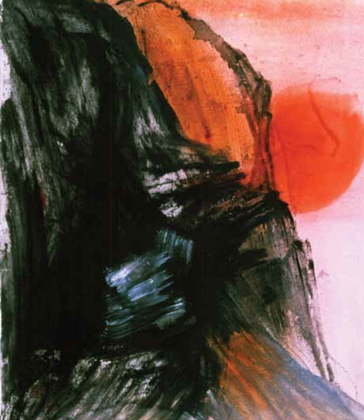
Lucille Wong
Mastering a Silent Language
text by Sylvia Mendoza
photos by Miguel Méndez Díaz and Octavio Wong
Somewhere between bright colors and soft hues, free flowing abstracts and pronounced definition, “East meets West” in a culture clash that makes the art of Lucille Wong speak its own language. Whether she’s working on themes revolving around landscapes and nature, volcanoes and horses, nudes and human figures or using Sumi-E or abstract formats, one thing is for sure—art is a way of expressing thoughts and concepts—and of finding her place in a world where the paintbrush is her microphone and the canvas is her stage.
“I like to speak with this language,” Wong says. “It is a silent language. No words are needed to express the invisible. Painting uncovers the unknown in an instant. It is a path of growth. Art becomes life, like the air I breathe.”

Wong captures the essence of her upbringing—Chinese on one side of the family, Mexican and Texan on the other—and produces a unique blend of art and living. Raised in Mexico, her four grandparents and parents formed a solid platform of values and work ethic and embraced love, individuality, intuition and intelligence.
 “I can recall strong, industrious and hardworking persons,” she says. “No matter trial or struggle, they were always there to help and bring joy for life.” They detected and believed in her artistic talent early on. “I have beautiful memories of both of them: my mother teaching me to apply soft colors delicately with a piece of cotton, and my father giving me a small paintbox that he still kept from his childhood. And the three of us trying to copy a small boat painting by Monet.”
“I can recall strong, industrious and hardworking persons,” she says. “No matter trial or struggle, they were always there to help and bring joy for life.” They detected and believed in her artistic talent early on. “I have beautiful memories of both of them: my mother teaching me to apply soft colors delicately with a piece of cotton, and my father giving me a small paintbox that he still kept from his childhood. And the three of us trying to copy a small boat painting by Monet.”
Art started as a daily basis in kindergarten. “Sitting at my small table, I suddenly detected above my head, a hand carrying a basket full of crayons. The smell and colors are still with me.”

That passion took root and never wavered as she pursued a degree in modern literature from National Autonomous University in Mexico (UNAM) and a master’s degree in English literature at the University of Kent, England, while taking courses on Oriental culture at the Colegio de Mexico. Ultimately, every course she took, every place she traveled to, every teacher she studied under, influenced her work by “enriching her thematic cycles and world vision.”
During her time in England, however, she quit painting for a whole year. “It became inconceivable and painful,” she says. “I decided that my true language was painting.”
She also decided she would open her own studio and paint, no matter what. Before going home, she spent time in Florence, which fortified her decision. “The great master was the city itself.” Day by day, step by step, she enjoyed and learned from all the works of art that graced her path.
 Finally, in Sicily, on the top of Mt. Etna, the highest volcano in Europe, she had an epiphany as nature rendered elementary colors—red, blue, and yellow, along with the purest black and white—and she translated the palette with a need to make it her own. “The clear sky was deep blue, sulfur on the ground was mordent and yellow, a red spot was behind me. The clouds, like cotton balls, were bright white, and the crater was deep, deep black.”
Finally, in Sicily, on the top of Mt. Etna, the highest volcano in Europe, she had an epiphany as nature rendered elementary colors—red, blue, and yellow, along with the purest black and white—and she translated the palette with a need to make it her own. “The clear sky was deep blue, sulfur on the ground was mordent and yellow, a red spot was behind me. The clouds, like cotton balls, were bright white, and the crater was deep, deep black.”
The colors and image stayed with her.
Since then she has participated in 37 individual exhibitions and in more than 150 collective – throughout Mexico, the United States, Canada, Chile, Panama, France, Spain, Italy Switzerland, Sweden and Japan. She staged her first individual exhibition in 1974 and others followed. Using a variety of methods and top quality materials like acid-free or handmade papers, and original pigments, her art has grown a reputation as “millenarian Oriental art and modern impressionism.” Studying abroad and in workshops with Robin Bond, Guillermo Santi, Koyo Okamoto and Luis Nishizawa, among others, it was a time of discovery.
“They helped me to discover my genetic baggage—East meets West—by teaching me formal approach to oil painting and Sumi-E, and helped me find my own language.”

That language has led to more than original paintings. She produces limited editions of mixed media and graphic art, photography, illustrated bookcovers, and so much more, creating unique masterpieces. “Piece by piece, each unit is one of a kind.”
She challenges herself to find new ways to express her art. In an original portfolio of mixed media, for example, 37 Ways to Depict Light combined visual and musical language. The music was written by E.R. Blackaller (Three Suites for Piano, inspired by images of Lucille Wong) and the exhibit was touted as creative genius.

“As the old Masters in China said: Ink is the blood, the brush is the extension of the hand, and the white paper is the place where Nature and Spirit mingle,” she says. And for Wong, all of it together produces a language that speaks to her—and that she has mastered.
